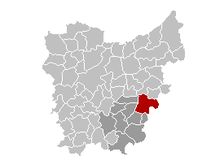Aalst, Belgium
| Aalst | ||||||
|---|---|---|---|---|---|---|
|
||||||
 |
||||||
 Aalst, Belgium
Location in Belgium
|
||||||
| Sovereign state | ||||||
| Region | ||||||
| Community | ||||||
| Province | ||||||
| Arrondissement | Aalst | |||||
| Coordinates | ||||||
| Area | 78.12 km² | |||||
| Population – Males – Females – Density |
77,360 (2006-01-01) 48.84% 51.16% 990 inhab./km² |
|||||
| Age distribution 0–19 years 20–64 years 65+ years |
(01/01/2006) 19.73% 60.87% 19.20% |
|||||
| Foreigners | 2.43% (01/07/2005) | |||||
| Unemployment rate | 9.00% (1 January 2006) | |||||
| Mean annual income | €13,817/pers. (2003) | |||||
| Mayor | Ilse Uyttersprot (CD&V) | |||||
| Governing parties | CD&V, VLD, SP.A | |||||
| Postal codes | 9300, 9308, 9310, 9320 | |||||
| Area codes | 053 | |||||
| Website | www.aalst.be | |||||
Aalst (French: Alost) is a city and municipality on the Dender River, 19 miles northwest from Brussels. It is located in the Flemish province of East Flanders. The municipality comprises the city of Aalst itself and the villages of Baardegem, Erembodegem, Gijzegem, Herdersem, Hofstade, Meldert, Moorsel, and Nieuwerkerken-Aalst. The current mayor of Aalst is Ilse Uyttersprot, from the CD&V (Christian-Democrats) Party. The town has a long-standing feud with Dendermonde (situated north along the same river), which dates back from the Middle Ages.
Contents |
History

The first historical records on Aalst date from the 9th century, when it was described as the villa Alost, a dependency of the Abbey of Lobbes. During the Middle Ages, a town and port grew at this strategic point, where the road from Bruges to Cologne crossed the Dender. In the 11th century, Aalst was transferred from the pagus of Brabant to the County of Flanders. Its frontier position on the border of the Holy Roman Empire allowed the town to keep a certain degree of independence. Its relation with Brabant has been preserved in the city’s white and red coat of arms, the colours of Lotharingia.
Construction of the town hall began in the middle of the 12th century[1], and is the oldest surviving town hall in Belgium. Several manuscripts from this period still survive in the town archives. The town hall, and the city itself, were almost entirely destroyed by fire in 1360. The town was soon rebuilt and a new belfry in gothic style was build in the 15th century. This was a time of great prosperity for the city, dominated by the powerful weavers' guild. It is also at that time that Dirk Martens, a local citizen, became the Southern Netherlands’ first printer, founding a printing shop in 1473 that published books by various authors including Christopher Columbus; Martens would later become a professor at the Catholic University of Louvain[1].
Aalst suffered considerably under the Eighty Years' War (1568–1648). It was later taken by the French Marshal Turenne in the War of Devolution of 1667, then occupied by France until 1706 along with Southern Flanders in general. The textile-based economy flourished under the French. The 19th century was marked by social crises engendered by the Industrial Revolution, with Father Adolf Daens and his Christene Volkspartij emerging as the local defender of workers' rights. The 20th century was marked by occupation by the Germans during both world wars[1].
Industry
The textile industry is still vibrant in Aalst, in part because of the French occupation. Aalst produces not only the textiles themselves, but manufactures many of the needed machines. The more rural regions are noted for their production of hops, which are sold to the old breweries there.
Events

Aalst is famous for its carnival festivities, celebrated every year in February. A Prince Carnaval is elected, who is allowed to "rule" the city for three days. A big parade crosses the city on Sunday, with about 70 groups of costumed volunteers and parade cars. Carnaval Tuesday or Shrove Tuesday (by tradition, the day before Ash Wednesday), is known as the day of the 'Voil Jeannetten' (literally: "the Dirty Jennies"), i.e. men dressed as women. The festivities traditionally end with the "Burning of the Doll", happening on Tuesday evening.
Sites of interest
- The famous St. Martin's Collegiate Church, in Gothic style, dates back to 1480. It contains a famous painting by Rubens, "Saint Roch beseeching Christ to terminate the Plague at Aalst", and it has also a beautiful tabernacle (dated 1605), which features sculptures made by Hieronymus Duquesnoy the Elder.
- The belfry in the town hall, one of the oldest and most handsome of Flanders, contains a 52-bell carillon[1]. Together with the adjacent Aldermen’s House, it was classified by UNESCO as a World Heritage Site in 1999.
- The statue of Dirk Martens (1446–1534), first printer in the Netherlands.
Famous inhabitants
- Pieter Coecke van Aelst (1502–1550), painter
- Adolf Daens (1839–1907), priest and politician
- Franz Cumont (1868–1947), archeologist, historian, and philologist
- Louis D'Haeseleer (1911–1988), politician
- Louis Paul Boon (1912–1979), writer
- Mark De Bie (b. 1939), television writer
- Sabine Appelmans (b. 1972), tennis player
- Peter Van Der Heyden (b. 1976), Belgian and international soccer player
- Rik D'Hiet (b. 1965), television writer (Recht op Recht, Flikken,...)
- Patrick Lateur (b. 1949), translator of Greek and Latin texts, poetry writer
- Jean-Paul Floru (b. 1969), British Conservative Party politician, City of Westminster Councillor
- Dimitri Verhulst (b. Aalst, 1972), writer and poet.
Twin city
See also
- Battle of Alost (1128)
- Battle of Alost (1914)
External links
- Official website - Only available in Dutch
References
- "Aalst." Encyclopædia Britannica
- "Aalst." Columbia Encyclopedia, 6th ed.
|
||||||||||||||||||||||


